Greek Coffee Definition, Recipe and Main Brands
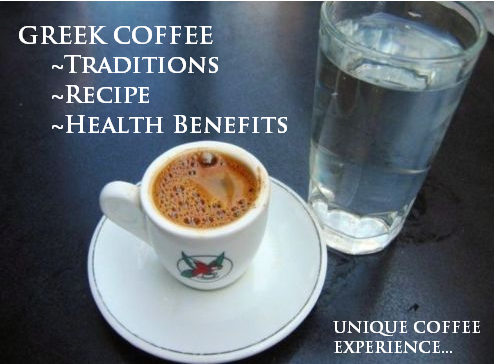 Greek coffee is a strong brew. Its serving requires foam on top and sediments at the bottom of the cup.
Greek coffee is a strong brew. Its serving requires foam on top and sediments at the bottom of the cup.
It’s a unique method of brewing coffee.
Its making instructions are very easy to follow. If you pay some attention to details you will look expert!
Nowadays, it diminished some kind in popularity. “Frappe” instant coffee became the first choice of caffeine drink among the young generation.
There is a big discussion about which one is the national coffee drink: Traditional Greek coffee or frappe?
Tourists will vote for traditional coffee opposed to many Greeks who go pro for frappe.
One thing is for sure. Most of the Greek families will offer you Greek coffee after meal and not frappe.
What is Greek Coffee?
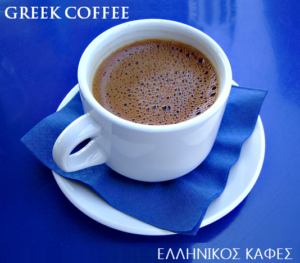 Greek coffee (“Ellinikos kafes”) is a demitasse cup of coffee. Powder ground coffee cooks in special pot. You serve it in “half cups”.
Greek coffee (“Ellinikos kafes”) is a demitasse cup of coffee. Powder ground coffee cooks in special pot. You serve it in “half cups”.
It’s a strong unfiltered caffeine beverage. You make it in a special pot known as “briki”.
This utensil helps in creating foam on top (called “kaimaki”).
Greek ground coffee manufacturers use light roasted beans for this type of coffee. That’s why the final product has a light brown appearance.
Have in mind that Greeks don’t use spices in their coffee (cardamom, cinnamon, cloves etc.).
Greek Coffee History
Ottoman Turks introduce Greece to coffee. The country was a part of the Ottoman Empire for almost 400 years (1453 – 1821).
Loumidis brothers were the first to introduce ready ground coffee in Greece. In 1913 they came to Piraeus from their village.
They learned the art of coffee roasting as workers. By 1919 they had their own first shop selling coffee to the public.
 Loumidis coffee became the #1 preferable Greek ground coffee in mainland Greece and among the Greek expatriates worldwide.
Loumidis coffee became the #1 preferable Greek ground coffee in mainland Greece and among the Greek expatriates worldwide.
The Samourkas family was the second part of the Greek coffee history. In 1923 the family started a coffee shop business in Athens. Slowly and steady two of the family members proceeded in establishing the BRAVO coffee industry.
 Under innovative management Bravo succeeded to become a very successful company with loyal customers throughout the world.
Under innovative management Bravo succeeded to become a very successful company with loyal customers throughout the world.
The company is the second largest exporter of Greek ground coffee worldwide.
Up to mid 1950’s Greece was calling this type of coffee with its original name; Turkish coffee.
In 1955 Turkey expelled Greeks from Istanbul. The relations of the two nations deteriorated.
Greeks reacted against anything that had the word “Turkish” in their everyday life. It goes without saying that they deleted “Turkish coffee” from the Greek vocabulary.
After the Turkish invasion to Cyprus in 1974, Greece permanently established “Greek coffee” as the correct name for its coffee.
Greek Coffee Culture and Traditions
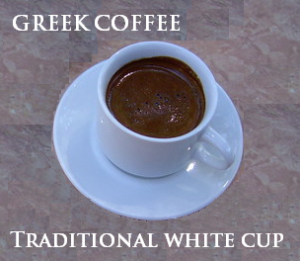 Coffee in Greece is an important part of its people daily life. A lot of traditions in Greek culture have a starting point with a cup of coffee.
Coffee in Greece is an important part of its people daily life. A lot of traditions in Greek culture have a starting point with a cup of coffee.
It includes many traditions. Neighborhood relations, coffee shop male gatherings, weekend visits and consolation events are a few of them.
Greeks serve their traditional coffee in a thick cup for a useful reason. It should stay the longest possible.
They sip it slowly and do not just take it as a shot like espresso.
A) Neighborhood Relationships and Greek Hospitality
A very significant tradition in the Greek culture is neighborhood relations. Daily invitations for morning coffee break are very common among women neighbors. It’s a means of exchanging news and local gossips.
Needless to say that non-participants find difficult time in the community.
Greek households propose a coffee treat to the guests they happen to have as an act of hospitality. This is a very strong tradition, mainly in the villages.
The toast “To your good health” is the correct way of addressing the landlords.
B) Traditional Coffee Shop - “Kafeneio”
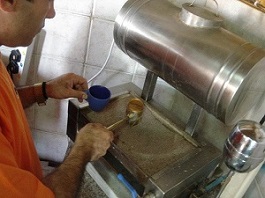
Cafes in Greece are a major part of the Greek culture. “Kafeneio” is the traditional local coffee shop. It is the meeting place of the older male generation. Over the enjoyment of their traditional coffee they can do lots of activities:
- Read newspapers.
- Discuss (loudly most of the times) about current country’s or local events. (Politics and soccer are the most favorable topics).
- Play cards or backgammon.
Here you can taste Greek coffee made in copper briki. In some occasions, if you are lucky, you can taste coffee in “hovoli” (hot sand).
Its serving requires traditional thick white demitasse cup. (It’s a special very thick cup that holds coffee warm for long time).
In “kafeneio” you can enjoy a double dosage (“diplos”) of Greek coffee with the right texture. Its special cup (thick, heavy, narrow top, wide bottom) can hold foam on a large surface.
Note: Regular coffee/tea cups don’t have these small details for the right double Greek coffee.
In the villages and the islands you usually find “kafeneio” at the central square. Ouzo, local brandy and beer are some other drinks that you can find in A Greek coffee shop.
A small “meze” plate accompanies these alcoholic beverages. It usually includes a few olives, some feta cheese, tomato and cucumber slices.
C) Weekend Visits with Greek Coffee Grounds Reading
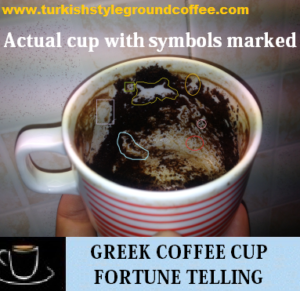 Saturday or Sunday afternoon coffee invitations are very popular in the Greek culture. The hostess serves Greek coffee with pastries (savory and sweet) over long chats on recent events or family affairs.
Saturday or Sunday afternoon coffee invitations are very popular in the Greek culture. The hostess serves Greek coffee with pastries (savory and sweet) over long chats on recent events or family affairs.
A successful Greek coffee gathering should end with cup readings. If there is an “expert” in the group things will get much better.
Guests enjoy interpretations of their coffee grounds with seriousness, fun and lots of jokes.
Coffee cup reading is a very serious matter in the Greek culture with lots of followers (mainly female Greek population).
The procedure is the same as I described it in full details in my special coffee reading webpage. There you can get all the information you might need plus a FREE list of 200+ symbols.
Most of the Greek coffee readers follow this cup division pattern:
-HANDLE AREA = Events that are happening right now.
 -FRONT RIM AREA = Future or sudden events with no relation to the home environment.
-FRONT RIM AREA = Future or sudden events with no relation to the home environment.
Rim area = Positive meaning.
-LEFT handle area = Past.
-RIGHT handle area = Today or near future (tomorrow up to a week).
Sides of the cup = Present or near future events (up to 2 week time).
Bottom of the cup = Long future events (up to 1 month time).
Bottom area = Negative meaning.
D) Consolation Events
Greek culture calls for coffee after funerals or memorial services. Family members and friends gather in the house of the dead (or any other place that the family announces).
They drink coffee with special dry cookies (“paximadia”) in Memoriam of the deceased. A shot of local brandy/cognac accompanies the serving tray.
Greek Coffee Recipe – Ellinikos Kafes
This is an easy to follow guide on how to make the best Greek coffee. The recipe is authentic. The final result will make you look professional.
The needed utensils
Before you proceed with the recipe you should have the two necessary equipment (briki & demitasse cup) and of course the main ingredient that is Greek ground coffee.
BRIKI - Long-handled Greek coffee maker. Greek households prefer their briki pot made of stainless steel.
Depending on the quantity you will make you need and the equivalent size of briki coffee pot.
Two different sizes are a MUST to own to fulfill any kind of orders.
CUP - Demitasse cup (“half cup”) or Espresso style cup. The classic Greek cup asks for thick porcelain. Its color is mostly white and some times with ancient Greek culture patterns.
The traditional coffee shops mainly use the plain white (usually with coffee brand logos).
A nice substitute to them could be the “white espresso cups”. It is easier for you to find in many different stores.
Nowadays, contemporary Greek households often use espresso cups with floral and neutral decorations to serve the coffee.
GROUND GREEK COFFEE - There are many choices in many online stores if you are not able to spot it in the ethnic food sections of supermarkets.
Greek households are not favoring the use of hand-mills to grind roasted coffee beans. They mostly buy the commercial Greek brands of ready ground coffee.
The recipe
Ingredients (for 1 cup):
- 1 demitasse cup (espresso cup) of drinkable bottle water.
- 1 heaped teaspoon of Greek ground coffee.
- Sugar according to your taste. (1 teaspoon is the most common amount).
How to make Greek coffee:
1) Put water, ground coffee and sugar (if used) into a 1-cup sized Greek coffee pot (“briki“).
NOTE: Never use a big size briki for small quantity of coffee. You will end up with a boiled black beverage without foam.
2) Place briki on gas stove, low heat. (Avoid electric type appliances if you can. They are very difficult in controlling the rising foam. Lots of Greek households use the small camping gas stove burner (“gazaki”) for this task.
3) Stir well with a teaspoon to dissolve all the ingredients. Stop stirring and place the teaspoon aside. You won’t stir again. You will ruin the heart of the coffee; “kaimaki” (foam).
The cooking process
4) Simmer and pick up the briki a little bit off the flame to avoid boiling. Continue simmering. You will see an outer rim ring of foam.
5) Lower the heat a little more and watch carefully the foam ring which closes and pushes coffee up.
6) Take the briki off the heat quickly. The ring shouldn’t close completely. (That’s where the spillover might happen if you don’t act fast).
7) Turn the briki around for a few times. The foam should settle down.
8) Pour half of the coffee with most of its foam into the cup. (Rich foam always means successful making).
NOTE: If you make 2+ cups this step is extremely important. You have to spread the foam among the cups. Non-experts should use a teaspoon to help them distribute the foam.
9) Return briki to the heat.
10) Simmer again. The remaining foam in the briki will start rising up. Wait to reache the stage of boiling point and remove.
11) Fill up the cup by pouring coffee from a height of 3 inches to create bubbles on the foam. (Greek pop culture considers bubbles as a sign of love and wealth).
12) Serve with a glass of cold water and a Greek cookie or even better with a spoon sweet.
NOTE: Traditionally, Greeks DO NOT accompany their coffee with candy delight. There are some exceptions in certain geographical areas that are under Turkish culture influence.
![]()
Watch this video to learn from a Greek lady the basic steps of the traditional making of Greek coffee.
![]()
Greek Coffee Sweetness Guidelines
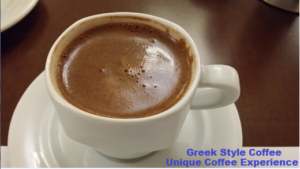 Your sugar preference is the number one question you will get in ordering Greek coffee. Unfortunately, you cannot add sugar in the ready coffee.
Your sugar preference is the number one question you will get in ordering Greek coffee. Unfortunately, you cannot add sugar in the ready coffee.
The stirring will ruin the foam and “disturb” the bottom grounds.
Here are four ways that the majority of the Greeks use to order their coffee:
- “Sketos”: Plain. Without any sugar.
- “Me oligi”: With little sugar. 1/2 teaspoon.
- “Metrios”: Medium-sweet. 1 teaspoon of sugar.
- “Glikos”: Sweet. 2 teaspoons of sugar.
A few more ordering variations exist mostly among the clientele of a coffee shop (“kafeneio”).
The orders mainly describe dosage amount of ground coffee and the quality of the foam. Here are two examples:
- “Vari glikos”: Heavy-Sweet. 2 teaspoons coffee - 3 teaspoons of sugar.
- “Gliki vrastos”: Sweet-with little foam. (Rising the foam 3+ times)
Home Greek Coffee Serving
The Greek households traditionally serve the coffee to their guests on trays with Greek key motif or plain ones.
DO NOT confuse them with the Turkish trays which have heavy Ottoman decor.
Chrome or silver plated even stainless steel trays are very common in Greek households. Small touches of Greek culture patterns / motifs give a big plus in the coffee presentation.
A cold glass of water always accompanies Greek coffee.
Small desserts are a part of the scene as well. The most common of them are:
- Greek butter cookies (“koulourakia”).
- Non-dairy, grape molasses cookies (“moustokouloura”).
- Traditional spoon-sweets (“glyka koutaliou”). Chunks of preserved fruits or vegetables in heavy syrup.
Greek Coffee Health Benefits
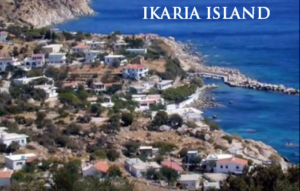 In recent years Greek coffee gained a lot of respect regarding health benefits. The Ikaria study and Dr. Oz TV episodes gave it a new perspective.
In recent years Greek coffee gained a lot of respect regarding health benefits. The Ikaria study and Dr. Oz TV episodes gave it a new perspective.
Dr. Siasos analyzed the advantages of Greek coffee in his study of the Ikarians.
The conclusion of his research ended with one fact:
“Greek coffee could be a key for long life“
TV personality Dr. Oz pointed out the health benefits of Greek coffee. Heart health and Greek coffee have a strong association.
The word “super-food” started showing around in many internet forums and blogs.
Greek Coffee for Longevity: the Ikaria Study
Greek coffee might offer heart health benefits. Dr. Gerasimos Siasos contacted a research study that shows a positive connection between consumption of Greek coffee and good cardiovascular health.
Vascular Medicine journal published his results in March 18, 2013.
(Full article at: http://vmj.sagepub.com/content/18/2/55.long)
Dr. Siasos (Athens Medical School) and his team went to the Greek island of Ikaria for their research.
They found 142 volunteers (71 men-71 women) who lived in the island continuously. Their age was over 65 years old.
Why Ikaria and not any other Greek island?
The reason is that simple. The Ikarians have the highest healthy longevity in the world.
Approximately one third of the inhabitants are 90+ years old.
The results showed that 87% of the participants who consumed Greek coffee daily had better endothelial function.
The study presented reduction of heart disease and risk of heart stroke in comparison with different types of coffee consumers.
Greek Coffee: Dr. Oz Gives His Opinion on its Health Benefits
 In April 2013, the famous Turkish-American cardiologist Dr. Mehmet Oz stated in his TV show that boiled Greek coffee has the elixir to longer life.
In April 2013, the famous Turkish-American cardiologist Dr. Mehmet Oz stated in his TV show that boiled Greek coffee has the elixir to longer life.
Its main benefit according to Dr. Oz is its ability to reduce the chance of a heart disease. He suggests a dosage of three to five demitasse cups per day. (Note: 1 demitasse cup = 2 fl. oz. / 60 ml).
For Dr. Oz Greek coffee is healthy and extends life. He based his statement on two facts:
- First, coffee boiling extracts lots of nutrients.
- Second, the powder coffee grounds give more concentrated antioxidants per ounce of drinking liquid.
He stressed out the low caffeine content of the Greek coffee.
This detail contributes a lot to its health benefit picture. (According to caffeineinformer.com 1 cup of Greek coffee (“Metrios“) contains 50 mg of caffeine).
![]()

































